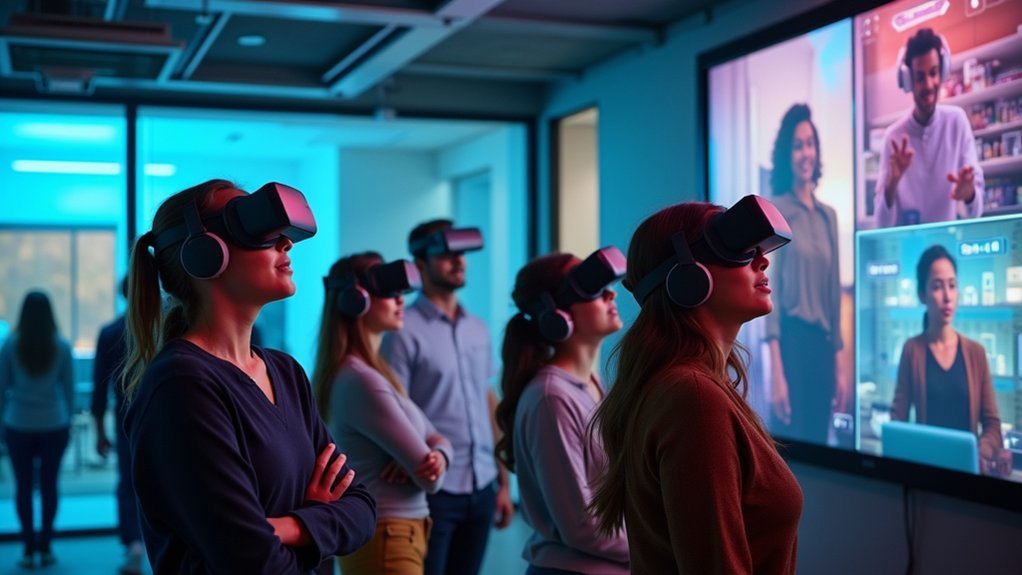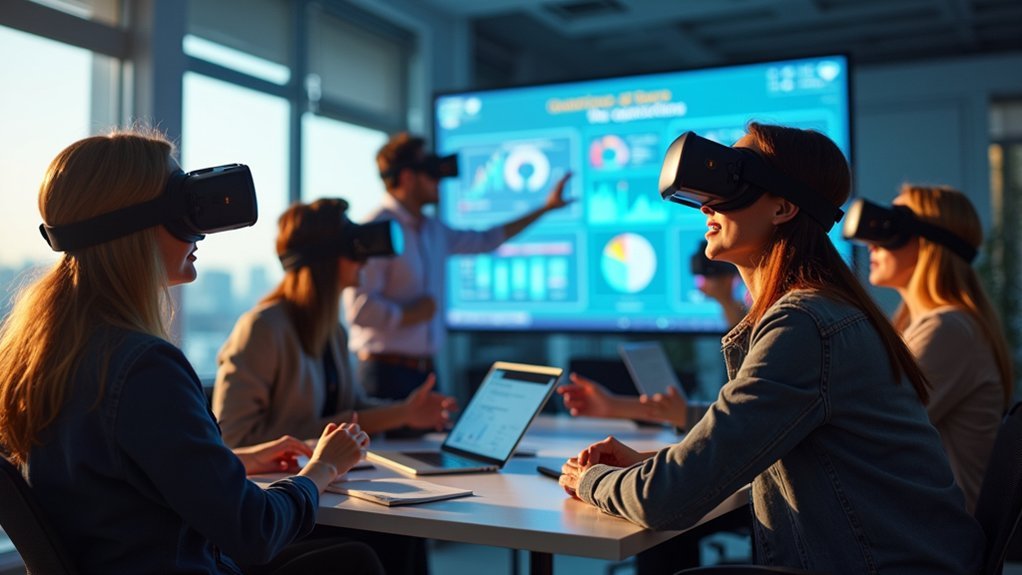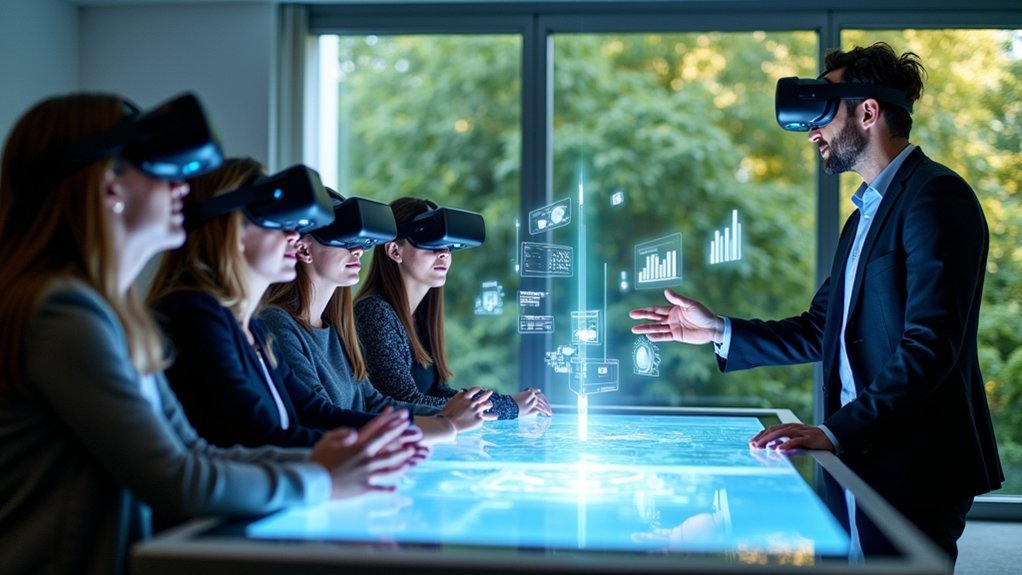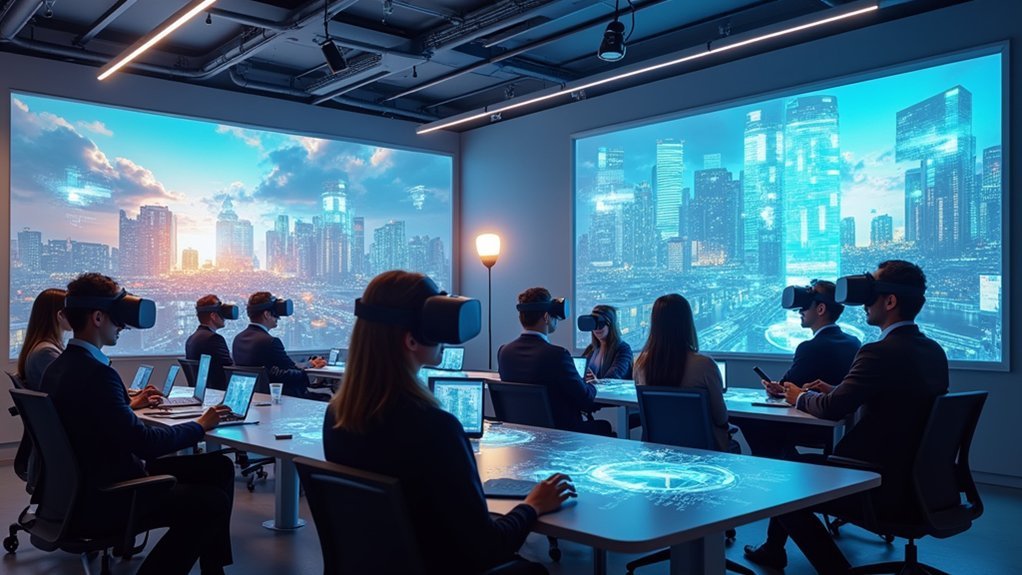To implement VR onboarding, start by evaluating your infrastructure and budget requirements, ensuring you have compatible hardware like VR headsets with 8GB RAM and powerful GPUs. Define clear objectives focusing on reducing training time and improving retention rates, then select appropriate technology platforms. Design immersive content that addresses visual, auditory, and kinesthetic learning styles while incorporating gamification elements. Launch pilot programs with select employee groups, gather feedback through surveys, and partner with expert vendors for scalable solutions that’ll maximize your program’s effectiveness.
Understanding Virtual Reality Onboarding and Its Business Impact

While traditional onboarding methods often leave new employees feeling overwhelmed and underprepared, virtual reality onboarding transforms this critical process by immersing hires in realistic simulations that mirror their actual work environment.
VR onboarding delivers measurable business results you can’t ignore. Your training time plummets dramatically – Walmart reduced technology training from 8 hours to just 15 minutes, achieving a 96% decrease.
You’ll see improved employee retention rates, with some organizations experiencing 31% increases through engaging training experiences that reduce overwhelm. The immersive experience enhances job performance by building confidence – 94% of participants feel better prepared after VR training.
Additionally, your company culture values stick 16 times better than traditional methods, creating lasting organizational alignment.
Assessing Your Organization’s Readiness for VR Implementation
How do you determine if your organization is truly ready to embrace VR onboarding technology? Evaluating an organization’s readiness for VR implementation requires a thorough examination of multiple factors.
Start by examining your existing technology infrastructure to guarantee compatibility with VR systems. Determine budget allocations for necessary hardware and software investments.
Next, identify specific skills and knowledge gaps within your workforce that VR training can address effectively. Consider employee demographics and learning preferences, especially since over 80% of employees feel overwhelmed by traditional onboarding methods.
Most employees struggle with conventional onboarding approaches, making VR training essential for addressing workforce skill gaps and learning preferences.
Conducting a pilot program helps gauge comfort levels and engagement with VR technology before full deployment.
- Employees wearing VR headsets in a modern training room
- IT specialists reviewing network capabilities and hardware requirements
- Diverse team members experiencing immersive virtual workplace scenarios
- Budget meetings discussing VR investment allocations
- VR experts demonstrating customized onboarding modules
Engaging with VR experts guarantees tailored content development.
Defining Clear Objectives and Success Metrics for VR Onboarding

You’ll need to establish specific, measurable goals for your VR onboarding program that directly support your organization’s broader objectives.
Setting clear key performance indicators helps you track progress and demonstrate the program’s value to stakeholders.
Your data collection strategy should capture both quantitative metrics and qualitative feedback to provide a thorough view of your VR onboarding effectiveness.
Setting Measurable Onboarding Goals
Before implementing VR onboarding technology, you need to establish concrete goals that align with your organization’s broader objectives.
Setting measurable onboarding goals guarantees you can track success and make data-driven adjustments to optimize your program’s effectiveness.
Your measurable onboarding goals should focus on quantifiable outcomes that directly impact your organization’s performance:
- Reduce training time by specific percentages, like Walmart’s impressive 96% reduction in technology training
- Increase employee retention rates by 50% through stronger onboarding processes
- Achieve higher engagement levels with 94% of new hires feeling better prepared for job situations
- Decrease time-to-productivity for new employees entering their roles
- Improve overall job readiness scores through thorough VR training modules
These specific targets enable you to evaluate your VR onboarding program’s return on investment and continuously refine the experience for maximum impact.
Key Performance Indicators
Once you’ve established your measurable onboarding goals, you’ll need specific key performance indicators to track whether your VR program actually delivers results.
Focus on three essential metrics: onboarding time reduction, employee engagement levels, and retention rates. Monitor completion rates across your VR training modules to identify where new hires struggle most. This data reveals curriculum weak spots requiring immediate attention.
Deploy employee feedback surveys regularly to gauge satisfaction and gather insights for continuous improvement.
Compare job performance metrics between VR-trained employees and those from traditional onboarding methods. This comparison quantifies your immersive training’s real impact on productivity.
Track these key performance indicators consistently to demonstrate ROI and justify your VR investment to stakeholders.
Data Collection Strategies
Effective data collection transforms your VR onboarding program from guesswork into strategic advantage.
You’ll need robust data collection strategies that capture meaningful insights throughout the entire employee journey. Continuous data collection allows you to monitor onboarding time, employee engagement levels, and retention patterns in real-time.
Your success metrics should include:
- Onboarding completion rates – Track how many employees finish each VR module
- Engagement heat maps – Monitor where employees spend time and interact most
- Knowledge retention scores – Measure learning effectiveness through assessments
- Time-to-productivity metrics – Calculate how quickly new hires become effective
- Satisfaction ratings – Gather sentiment data through post-experience surveys
Deploy feedback forms immediately after each VR session to capture fresh impressions.
Real-time evaluation enables you to adjust content and experiences before issues impact larger groups.
Selecting the Right VR Technology and Hardware Solutions

You’ll need to establish specific hardware performance requirements that support smooth, high-quality VR experiences for your onboarding participants.
Your chosen headsets must deliver crisp graphics and responsive tracking while maintaining ergonomic comfort during extended training sessions.
Consider how different VR platforms integrate with your existing corporate systems and whether they offer the compatibility needed for seamless deployment across your organization.
Hardware Performance Requirements
Three critical factors determine whether your VR onboarding program succeeds or fails: processing power, visual clarity, and user comfort. Your system needs at least 8GB RAM and a powerful GPU to deliver smooth immersive experiences.
VR headsets should feature minimum 1080p resolution per eye to prevent eye strain during extended training sessions. Hardware performance directly impacts employee engagement. You’ll want wireless options like Oculus Quest 2 for enhanced mobility during onboarding activities.
Confirm compatibility with enterprise software platforms—HTC Vive and Valve Index support extensive business applications. Don’t overlook ergonomic designs when selecting equipment. Adjustable straps and lightweight builds minimize fatigue during prolonged sessions.
- Employees maneuvering virtual office environments without motion sickness
- Crystal-clear product demonstrations reducing training time
- Wireless freedom enabling natural hand movements
- Comfortable headsets worn for hours without discomfort
- Seamless software integration across departments
VR Platform Compatibility
Selecting the right VR platform extends beyond hardware specifications to encompass seamless integration with your company’s existing technology infrastructure.
You’ll need to verify VR platform compatibility with your current systems to avoid costly workarounds or technical bottlenecks. Prioritize platforms featuring ergonomic design elements that minimize motion sickness, ensuring employees remain engaged throughout onboarding sessions.
Evaluate scalability options carefully, as your chosen solution must accommodate growth without exponential cost increases.
Look for robust mobile device management capabilities that streamline headset deployment across multiple locations.
Most importantly, select platforms supporting interactive content creation tools. These features allow you to customize experiences that align with your specific training objectives and organizational culture, maximizing onboarding effectiveness while maintaining budget constraints.
Developing Immersive Content That Aligns With Learning Styles
When developing immersive VR content for corporate onboarding, you must design experiences that simultaneously engage visual, auditory, and kinesthetic learners to maximize knowledge retention across your diverse workforce.
Your VR onboarding experience should incorporate interactive elements and real-life scenarios that promote active involvement, leading to better concept internalization than traditional methods.
Create tailored VR content that reflects specific workplace tasks and challenges your employees will encounter. This practical relevance boosts engagement and builds confidence in skill application.
Include gamification elements to increase motivation and make the engaging learning experience more enjoyable and impactful.
- Virtual office tours with interactive hotspots revealing department functions
- Role-playing scenarios mimicking challenging customer interactions
- Hands-on equipment simulations for technical skill development
- Interactive presentations combining visual graphics with spatial audio
- Achievement badges activated through successful task completion
Partnering With Expert Vendors and XR Management Platforms
Building compelling VR content requires the right technology partners and management systems to bring your vision to life effectively. Partnering with expert vendors streamlines your immersive onboarding implementation by providing access to cutting-edge VR technology and specialized support.
Independent software vendors offer guided implementation services and create tailored content that aligns with your organizational goals.
XR-specific Mobile Device Management solutions enable centralized control of your VR headsets, allowing you to manage settings, track inventory, and oversee user experiences efficiently.
Before full deployment, conduct pilot tests with your vendor partners to evaluate program effectiveness and gather essential feedback for improvements.
Maintaining ongoing content development partnerships guarantees your VR training materials stay current and relevant, adapting to evolving business needs while maximizing your immersive onboarding investment.
Launching Pilot Programs and Gathering Employee Feedback
Before committing to a full-scale deployment, you’ll want to launch targeted pilot programs that test your VR onboarding system with select employee groups. These initial phases let you evaluate whether your content resonates with new hires and delivers an engaging experience.
During pilots, you’ll collect employee feedback through surveys and forms that assess comfort levels with VR technology and training modules effectiveness. This data drives continuous improvement by revealing what works and what doesn’t align with your company culture.
Employee feedback during VR pilots reveals what resonates with your company culture and drives meaningful improvements to the onboarding experience.
- New employees wearing VR headsets exploring virtual office spaces
- HR managers observing real-time engagement metrics on dashboards
- Teams reviewing feedback surveys highlighting user experiences
- Developers refining scenarios based on employee suggestions
- Leadership analyzing retention data comparing traditional versus VR onboarding
Regular analysis helps refine your approach before full implementation.
Scaling Your VR Onboarding Program Across the Organization
After validating your VR onboarding approach through successful pilots, you’ll need to expand the program systematically across your entire organization.
Establish clear objectives that align with company goals, ensuring your training program meets each department’s specific needs. Collaborate with independent software vendors to create tailored VR content that scales across diverse roles for new hires.
Implement VR-specific Mobile Device Management solutions to streamline headset deployment and maintain consistent experiences.
Continue gathering feedback from early adopters while rolling out to additional departments incrementally. This phased approach allows you to refine your effective onboarding process based on real user experiences.
Monitor key metrics like employee engagement and retention rates throughout expansion.
Regular analysis helps identify improvement opportunities, ensuring your VR onboarding remains relevant and impactful organization-wide.
Frequently Asked Questions
How Do I Create a Virtual Onboarding Program?
Start by defining clear objectives focusing on skills development and cultural integration. Collaborate with vendors for customized content, design engaging virtual environments with gamification, implement feedback systems, and conduct pilot tests before full rollout.
What Is VR Onboarding?
VR onboarding uses virtual reality technology to train you as a new employee through immersive simulations. You’ll practice real workplace scenarios in a risk-free environment, building confidence and skills before starting actual job responsibilities.
What Is an Example of VR Onboarding?
You’d experience Bank of America’s VR onboarding by putting on a headset and virtually exploring the company’s history, practicing customer interactions, and participating in simulated training scenarios that teach corporate culture and values.
What Is a Virtual Onboarding Session?
You’ll experience an immersive VR training program that introduces your role, responsibilities, and company culture. You’ll take virtual office tours and practice real-world scenarios in a controlled, risk-free environment.





Leave a Reply